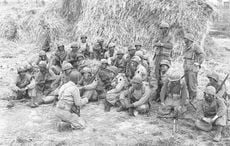A new book has reveal that Spike Island, located in Cork Harbour, was the largest prison in the whole of Ireland and British Isles, during the Victorian era.
The book, entitled Too Beautiful for Thieves and Pickpockets: A History of the Victorian Convict Prison on Spike Island, looks at the prison that was home to Ireland’s most notorious criminals during the mid to late 1800s. The Cork institution dwarfed institution such as Dartmoor, Pentonville, Mountjoy, and Kilmainham. According to their research Spike Island was a beacon of penal reform, influencing modern correctional systems in countries as far apart as the United States and Germany.
Years of research by Cal McCarthy and Dr Barra Ó Donnabháin constitute a major addition to the body of knowledge about the institution and the prevailing social, political, and economic conditions of the period. The new book, Too Beautiful for Thieves and Pickpockets, was compiled through official historic records and on-site archaeological excavations. It provides a comprehensive overview of the lives and times inside the famous penal institution.
The island was inhabited shortly after Christianity was introduced to Ireland when Saint Mochuda started a church on the 104-acre plot. He left 30 clerics on the island as he continued his mission around the country.
The island also became known as Fort Mitchell, Spike Island as a major staging point to transport Irish prisoners to the West Indies and Australia after the Cromwellian Wars in the 17th century. By the 18th century the coast of the rugged island had become a favorite hiding place for smugglers.
In 1779 the island was purchased by the British government from a local landowner. Then in 1790 the construction of the fortress, Fort Westmoreland began. It was named after the Lord Lieutenant, the Earl of Westmoreland. The first regular garrison moved on to the island in 1806.
It was in 1847 that the island became a depot for convicts. By 1850 there were over 2,000 detained there. The new book details the high death rates at the prison during the formative years due to malnourishment of the inmates.
The book tells not only the tales of those inmates in the prison but those who were sent around the world, to Australia and other destinations ended, and how most prisoners were encouraged to emigrate to the United States upon release.
Back in 2013 University College Cork’s Dr Barra Ó Donnabháin, leading the Spike Island Archaeological Project, identified the full extent of the convict mass graves on the site of the concentration camp-style prison in Cork harbor. The team identified 250 unmarked burial plots dating from Ireland’s Great Hunger. The mass grave is located inside the walled cemetery on Spike Island in Cork.
Ó Donnabháin told the Irish Examiner, “We have always known that this area contained graves but we never knew how many.
“There were about 11 headstones in this area, all dating from 1862, but which are not now in their original locations.
“Following geophysical analysis, we identified four or five rows with about 50 individual graves in each.”
He continued, “We now know that there are between 200 and 250 individual burials plots in this area — all were in a regimented, regular layout.”
At the time Ó Donnabháin said “Our findings begs the bigger question — what happened to the others who died on Spike?”
During its 36 years it is believed that 1,000 convicts died on the island, according to records and an estimated 900 convicts are buried on the island. These burial areas are seen on historic maps but the areas are now overgrown.
The doctor continued, “This project aims to give a voice to the men and boys who were incarcerated and died in the prison during the Victorian era, broadening our understanding of the role of the convict prison as one of the mechanisms by which the empire was established and maintained.
“I have no doubt that our work here will be of interest internationally and will attract many more international research projects and visitors to the region.”
The aim of this project is to be able to give these men a fitting memorial before Spike Island is developed as a tourist attraction.
Conditions under which the men were confined were very poor, however, Ó Donnabháin told the Examiner that though the conditions were harsh they were not designed to kill the men. Nonetheless a man would die almost every day.
In 1853 the numbers at the prison were lowered to 1,000 which lowered the death rate significantly but by 1883 1,000 convicts had died and were buried in mass graves.
Nowadays the Island is a tourist attraction. In 2011 the Cork County Council took over management of Spike Island to develop the historic sight as a tourism and heritage attraction, which can be accessed via ferry from Cobh.
For more visit www.spikeislandcork.ie.




Comments